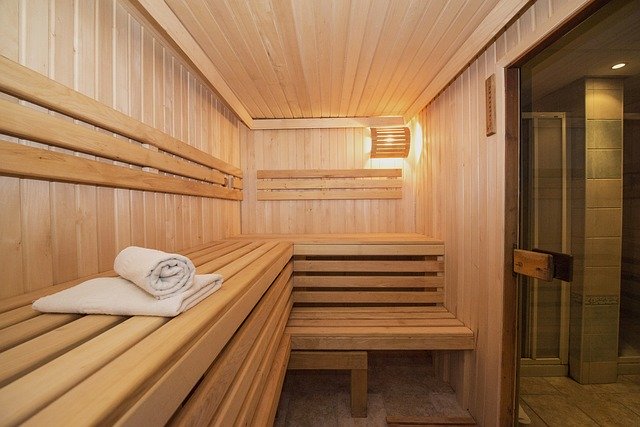Years ago, the Finnish stumbled upon a discovery: if you poured water over heated rocks in a tiny enclosed room, it created a very hot, dry heat. The healing and rejuvenating properties of this steam experience made it so popular in Finland that migrant Finns took the habit with them when they moved to different parts of the world. Becoming known to the world as the sauna.
Over time, saunas and sweat lodges became a way of life in cultures all over the world. In the last few decades, there has been a tremendous rise in popularity, with numerous versions becoming a part of health spas, gyms, resorts and even in the homes of the affluent. It is now used in several ways, for relaxation and socializing, as parts of a ritual, after sporting activities, or after childbirth.
While most of us associate a sauna with relaxation and recreation, there are several health benefits too. It is a natural and alternative way of treating a range of medical illnesses and conditions.

What are the benefits?
A sauna may not be suitable for you, depending on your age and current state of health, but there are many benefits to spending even 20 minutes in a room filled with steam. Here are just a few:
- Cleanses your skin and removes pores, leading to a healthy glow
- Increases circulation in the body by opening your airways and sinuses
- Eases muscle and rheumatic pain
- Boosts the immune system
- Provides enhanced joint movement and flexibility
- Relieves stress and tension
- Removes toxins and impurities by increased sweating
- Speeds up the healing process of infections
- Reduces the recovery time for injuries such as strains, sprains, arthritis and muscular pain
- Stimulates the endocrine glands thereby boosting mood, metabolism, tissue function, sexual function, and the reproductive process
A single session increases the amount of oxygen and nutrients delivered to your organs.
Can I replace working out with a sauna session?
In one word, not in the long term.
The benefits of a sauna are largely because it is a form of exercise simulation and makes you sweat. It can work like a cardiovascular aerobic workout by causing the blood vessels to dilate and open, increasing circulation and improving cardio output – without you needing to put in the effort of a workout.
The heat and humidity also make you sweat, causing the body to excrete toxins like harmful metals, alcohol, nicotine and other gases. The accumulation of these gases and toxins hinders the body’s natural healing. Sweating helps to eliminate these toxins and improve blood flow. In turn, more toxins can flow freely to the skin’s surface further cleaning out the pores.
For someone unable to exercise due to injury or medical conditions, a sauna will offer some of the benefits that an exercise session would. However, if you are healthy and able to exercise, you cannot replace a good workout with this. An exercise routine, especially if done with a personal trainer, helps you improve your muscular strength, offers greater joint and bone flexibility, and helps burn significant weight or maintain a healthy weight.

What are the different types of saunas?
The two most traditional forms are the dry and steam saunas. More recently, technological developments in space have created a new technique known as the infrared sauna.
Dry sauna
The most traditional form of sauna, the dry sauna involves the formation of tremendous heat by pouring water over heated rocks. This creates humidity levels of about 20%, allowing the body time to acclimatize as the rate of heat transfer is slow. This is why you can spend more time inside even if the thermometer hits 70 degrees Celsius.
Through this organic method of creating steam, the body benefits from the removal of toxic metals such as sodium, lead and cadmium. In a single session, you can end up burning over 300 calories, which is a long jog or an hour of weight training.
Steam sauna
A steam sauna is also known as a wet sauna because it maintains a humidity level of 100% and touches temperatures of about 35 to 50 degrees Celsius. Due to the high humidity, a steam sauna can be used with essential oils that are relaxing and also work as antibacterial and antiseptic agents.
A steam sauna is effective at relieving congestion and respiratory conditions by relaxing the airways and moistening the throat. It boosts circulation speeds up muscle recovery and is also useful in burning calories.
Infrared sauna
An infrared sauna is vastly different from a dry and steam sauna. It creates sweat by heating your body slowly from the core outwards, heating the water content inside the body. It uses a much lower temperature and gradual heating through the form of infrared radiation known as FAR rays.
Because it functions at a much lower temperature, an infrared sauna allows you to sit comfortably for a longer period than the other two forms of sauna. It is considered very effective at:
- Detoxing the body by removing toxins and accumulated metals
- Relieving stress and alleviating tension, thereby boosting mental health
- Reducing pain by aiding muscle recovery and relaxing muscles
- Helping to burn a tremendous amount of calories
- Clearing skin texture and improving complexion by increasing circulation
- Strengthening your cardiovascular system
What precautions should I take before I try a sauna treatment?
A sauna is a relatively safe and low-risk form of alternative therapy, but you should take the following precautions:
- You can expect to perspire quite profusely, so do make sure you replace lost fluids by drinking plenty of water before, during and after a sauna session. Without fluid replacement, you will feel fatigued and exhausted instead of refreshed and energetic.
- Make sure that no session lasts longer than 15 minutes and avoid more than 3 sessions in a single day.
- Do not drink alcohol before or during your session.
- If you have low blood pressure, remain alert during and after your session. Blood pressure can drop quite low after a single session.
- Do not eat a heavy meal before your session. Leave at least an hour between your last meal and the sauna so that you don’t have a full stomach.
- If this is your first time in a sauna, start with a short session of 15-20 minutes so that you can get used to the experience.
For a safe therapeutic sauna experience, stay focused on what your body is feeling. If you feel uncomfortable, faint, or nauseous at any point, leave the sauna and step into the fresh air.
Sauna etiquette for beginners
If you’re going to a sauna for the first time, you might be unsure about the rules. Here’s a quick round-up of tips:
- You can wear what you are comfortable in. Most people take a towel or a thin cotton shirt to wear inside, and some sit on a towel. You can also wear a swimsuit.
- If you have open wounds or new surgical scars, infectious skin conditions or the flu, you should avoid visiting a sauna.
- Usually, people avoid talking in a sauna. This time is meant to relax and focus on your breathing. To truly enjoy the benefits of a sauna and make the most of it, you should do the same.
If you are going to a spa or health resort, or if you have been invited to someone’s private sauna, you should feel free to call ahead and get all your questions answered.
Is a sauna recommended for everyone?
While the benefits of a sauna are enormous and it is a relatively safe activity, it is not recommended for everyone.
Avoid taking newborn babies or toddlers into a sauna. For older children, make sure there is adult supervision at all times.
A sauna is also not recommended for those who are pregnant, as well as those with low blood pressure, heart issues and diabetes.
If you’re not sure, it is recommended to check with your medical professional before a sauna session especially if you are taking medication.



